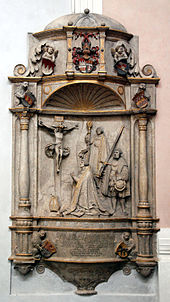Konrad II of Thüngen


Konrad II von Thüngen (* around 1466; † June 16, 1540 at the Marienberg Fortress in Würzburg ) was Prince-Bishop of Würzburg from 1519 until his death in 1540 .
Life
Konrad II von Thüngen came from the Franconian noble family of Thüngen , named after the Lower Franconian town of Thüngen . Other family members also obtained high ecclesiastical offices, for example Neidhardt von Thüngen (1545–1599) as Prince-Bishop of Bamberg .
Konrad II von Thüngen held the office of Prince-Bishop of Würzburg for almost 20 years. Its predecessor and successor came from the von Bibra family . Konrad II was buried in the Würzburg Cathedral.
Prince-Bishop at the time of the Peasant War
Konrad II von Thüngen was Prince-Bishop at the time of the Peasants' War , in which the diocese of Würzburg was one of the central focal points. The general dissatisfaction of the peasants with the overwhelming burden of taxes and compulsory labor led to escalating uprisings in the region. Different religious beliefs also contained explosives (see also Reformation ). Several thousand farmers came together in heaps and sometimes wreaked havoc in the surrounding villages and towns. However, they also found support and advocates in the citizenship of cities and the lower nobility. Well-known people such as Götz von Berlichingen or Florian Geyer played important roles. On the one hand, they showed understanding for the situation of the farmers, but on the other hand they tried to take mediating positions. While the prince-bishop initially got into great distress, was almost kidnapped and Würzburg was also besieged, the Swabian Confederation gradually gained the upper hand over the rather disorganized farmers. The one with some followers, u. a. Lorenz Fries , Konrad II, who had fled to Heidelberg to the Count Palatine Ludwig , returned. The Marienberg fortress , which had been held until then and which was also defended by Hofmeister Sebastian von Rotenhan , Konrad von Bibra and the commandant cathedral provost Margrave Friedrich von Brandenburg (1497–1536), was appalled. The peasants involved in the riot were punished severely, leaders were killed, others had their eyes gouged out and parts of their bodies chopped off.
Konrad acted relentlessly against the Anabaptists ; those he arrested were burned at the stake . During his tenure, the peasants ' unrest culminated in the Peasants' War , but also the partly Protestant nobility attacked and sacked the Würzburg area (see also Hans Thomas von Absberg and Ritterkrieg ). In 1523, the Swabian Federation passed through the bishopric and took action against robber knights from the Franconian region , including relatives of the prince-bishop from the Thüngen family.
coat of arms
The coat of arms of the von Thüngen family shows a golden bar in silver with three wavy red stakes. On the helmet with its red and silver covers stands the torso of a gray-bearded man in a red dress with a silver collar. His head is covered with a silver hooded red hood, which is equipped with cock feathers on the tip and on both sides.
The increased coat of arms of Konrad II von Thüngen is quartered. In addition to the family coat of arms in fields 2 and 3, the Franconian rake appears in field 1 as a claim to the Duchy of Franconia and in field 4 a flag for the diocese of Würzburg .
literature
- Franz Xaver von Wegele : Konrad II of Thüngen . In: Allgemeine Deutsche Biographie (ADB). Volume 16, Duncker & Humblot, Leipzig 1882, pp. 632-634.
- Hanskarl Freiherr von Thüngen: The Thüngen House 788–1988. History of a Frankish noble family. In the series Precious Lower Franconia . Echter Verlag, Würzburg 1988, ISBN 3-429-01162-0
- Alfred Wendehorst : Konrad II of Thüngen. In: New German Biography (NDB). Volume 12, Duncker & Humblot, Berlin 1980, ISBN 3-428-00193-1 , p. 532 f. ( Digitized version ).
- Scientific Association for the German Order e. V. and Historical Teutonic Order Compaigne zu Mergentheim 1760 e. V. (Hrsg.): 1300 years of Würzburg - signs of history, pictures and seals of the bishops of Würzburg . Issue 23. Lauda-Königshofen 2004, p. 44.
Web links
- Letters from Johannes Eck to Konrad II von Thüngen
- Increased coat of arms of Prince-Bishop Konrad II of Thüngen
- Chronicle of the Peasants' War in Tauber-Franconia (PDF; 81 kB)
- Konrad II. In Kirchberg an der Jagst - Fate of a Hohenlohe-Franconian City Volume I based on the manuscript estate of Judge-Martial Theodor Sandel at webisphere.de
Individual evidence
- ↑ Stefan Kummer : Architecture and fine arts from the beginnings of the Renaissance to the end of the Baroque. In: Ulrich Wagner (Hrsg.): History of the city of Würzburg. 4 volumes; Volume 2: From the Peasants' War in 1525 to the transition to the Kingdom of Bavaria in 1814. Theiss, Stuttgart 2004, ISBN 3-8062-1477-8 , pp. 576–678 and 942–952, here: pp. 580 f.
- ↑ see traveling iron woodcuts from 1523
| predecessor | Office | successor |
|---|---|---|
| Lorenz von Bibra |
Prince-Bishop of Würzburg 1519–1540 |
Conrad III. from Bibra |
| personal data | |
|---|---|
| SURNAME | Thüngen, Konrad II. Von |
| BRIEF DESCRIPTION | Prince-Bishop of Würzburg (1519–1540) |
| DATE OF BIRTH | around 1466 |
| DATE OF DEATH | June 16, 1540 |
| Place of death | Wurzburg |
